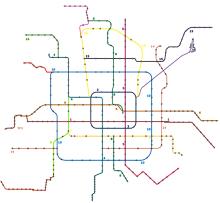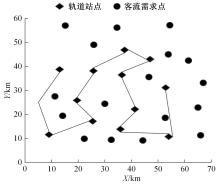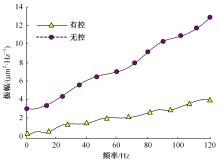Journal of Jilin University(Engineering and Technology Edition) ›› 2023, Vol. 53 ›› Issue (12): 3446-3451.doi: 10.13229/j.cnki.jdxbgxb.20221275
Optimization algorithm of urban rail transit operation scheduling based on linear programming
Qing-yong WANG1( ),Wei-qiang QU2(
),Wei-qiang QU2( )
)
- 1.School of Mechanical and Electronic Control Engineering,Beijing Jiaotong University,Beijing 100044,China
2.School of Information Science and Technology,Fudan University,Shanghai 200433,China
CLC Number:
- TP399
| 1 | 周康, 宋瑞, 彭虓. 城市轨道交通用地综合开发现状及对策[J]. 都市快轨交通, 2020, 33(2): 20-24. |
| Zhou Kang, Song Rui, Peng Yan. Current situation and countermeasures of comprehensive land development for urban rail transit[J]. Urban Rapid Rail Transit, 2020, 33(2): 20-24. | |
| 2 | 何胜学. 考虑目的地选择的交通流分配双层规划模型及算法[J]. 武汉理工大学学报: 交通科学与工程版, 2019, 43(4): 596-600. |
| He Sheng-xue. Bi-level programming model and algorithm for traffic flow assignment considering destination selection[J]. Journal of Wuhan University of Technology (Transportation Science & Engineering), 2019, 43(4): 596-600. | |
| 3 | 赖元文, 张杰. 基于模拟退火-自适应布谷鸟算法的城市公交调度优化研究[J]. 交通运输系统工程与信息, 2021, 21(1): 183-189. |
| Lai Yuan-wen, Zhang Jie. Urban bus scheduling optimization based on simulated anneal-adaptive cuckoo search algorithm[J]. Journal of Transportation Systems Engineering and Information Technology, 2021, 21(1): 183-189. | |
| 4 | 刘辉, 代学武, 崔东亮, 等. 基于参数自适应蚁群算法的高速列车行车调度优化[J]. 控制与决策, 2021, 36(7): 1581-1591. |
| Liu Hui, Dai Xue-wu, Cui Dong-liang, et al. Optimization of high-speed train operation scheduling based on parameter adaptive improved ant colony algorithm[J]. Control and Decision, 2021,36(7): 1581-1591. | |
| 5 | 马超群, 张爽, 陈权, 等. 客流特征视角下的轨道交通网络特征及其脆弱性[J]. 交通运输工程学报, 2020, 20(5): 208-216. |
| Ma Chao-qun, Zhang Shuang, Chen Quan, et al. Characteristics and vulnerability of rail transit network besed on perspective of passenger flow characteristics[J]. Journal of Traffic and Transportation Engineering, 2020, 20(5): 208-216. | |
| 6 | 达成, 钱勇生, 曾俊伟, 等. 城市轨道交通线网结构评价研究[J]. 铁道运输与经济, 2020, 42(2):122-127, 134. |
| Cheng Da, Qian Yong-sheng, Zeng Jun-wei, et al. A study on the evaluation of urban rail transit network structure[J]. Railway Transport and Economy, 2020, 42(2): 122-127, 134. | |
| 7 | 宋俪婧, 白同舟, 贺玉龙, 等. 基于混合整数非线性规划的接驳公交优化模型[J]. 交通运输系统工程与信息, 2022,22(3):104-111. |
| Song Li-jing, Bai Tong-zhou, He Yu-long, et al. Feeder bus routes and frequency optimization based on mixed integer nonlinear programming[J]. Journal of Transportation Systems Engineering and Information Technology, 2022, 22(3): 104-111. | |
| 8 | 周喜华, 贾洪信, 黄晓红, 等. 一种变量是梯形模糊数的两层多随从线性规划模型及其算法[J]. 工程数学学报, 2021, 38(1): 49-62. |
| Zhou Xi-hua, Jia Hong-xin, Huang Xiao-hong, et al. Model and algorithm of the bi-level multiple followers linear programming with trapezoidal fuzzy decision variables[J]. Chinese Journal of Engineering Mathematics, 2021, 38(1): 49-62. | |
| 9 | 许卫华, 郭海峰. 不同交通流状况下车辆分布式协同调度仿真[J]. 计算机仿真, 2020, 37(7): 178-182. |
| Xu Wei-hua, Guo Hai-feng. Distributed cooperative vehicle scheduling simulation under different traffic flow conditions[J]. Computer Simulation, 2020, 37(7): 178-182. | |
| 10 | 贾洪飞, 丁心茹, 杨丽丽. 城市潮汐车道优化设计的双层规划模型[J]. 吉林大学学报: 工学版, 2020, 50(2): 535-542. |
| Jia Hong-fei, Ding Xin-ru, Yang Li-li. Bi-level programming model for optimization design of tidal lane[J]. Journal of Jilin University(Engineering and Technology Edition), 2020, 50(2): 535-542. |
| [1] | Jing WANG,Feng WAN,Chun-jiao DONG,Chun-fu SHAO. Modelling on catchment area and attraction intensity of urban rail transit stations [J]. Journal of Jilin University(Engineering and Technology Edition), 2023, 53(2): 439-447. |
| [2] | ZHAO Xue-yu, YANG Jia-qi, PENG Ya-mei. Competitive and cooperative relationship evolution mechanism between urban rail transit and traditional bus [J]. 吉林大学学报(工学版), 2017, 47(3): 756-764. |
| [3] | YAO Xiang-ming, ZHAO Peng, YU Dan-dan. Dynamic origin-destination matrix estimation for urban rail transit based on averaging strategy [J]. 吉林大学学报(工学版), 2016, 46(1): 92-99. |
| [4] | CAO Yang, ZHAO Shu-zhi, TIAN Qing-fei. Urban rail transit subsidy policy based on maximum welfare [J]. , 2012, (03): 618-622. |
| [5] | ZHAO Shu-zhi, CAO Yang, TIAN Qing-fei. Urban rail transit scheduling decision based on information fusion [J]. 吉林大学学报(工学版), 2011, 41(增刊1): 85-88. |
| [6] | CAO Shou-hua,YUAN Zhen-zhou,ZHAO Dan. Queuing mechanism of passengers at exit stairs of urban rail transit [J]. 吉林大学学报(工学版), 2009, 39(06): 1463-1468. |
| [7] | Yang Li-ya;Shao Chun-fu . Integrated forecasting model for real estate price along urban rail transit based on BP neural network and Markov chain [J]. 吉林大学学报(工学版), 2008, 38(03): 514-0519. |
|
||





